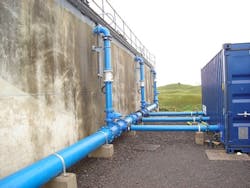Hydro Nation Reduces THMs
Scotland is blessed with a wealth of resources, including spectacular natural landscapes, a rich history and abundant fresh water. Because of the strategic and economic importance of its water resources, the “Hydro Nation” considers drinking water quality to be a national priority. As climate change and land use increasingly affect Scotland’s water resources, Scottish Water continues to invest in promising technologies to ensure that drinking water quality remains at the required standards for its customers.
The town of Oban, on the western coast of Scotland, epitomizes the opportunities and challenges that Scottish Water faces in delivering high-quality drinking water to its many customers. Known as the “Gateway to the Isles” and home to the famous Oban distillery, the town is an internationally recognized tourist destination. Its water treatment works primarily uses ozone and granular activated carbon filtration, and it was state-of-the-art when it was designed and built in 1976. But due to increasingly demanding water quality standards, Scottish Water wanted to explore new technologies to lower levels of trihalomethanes (THMs) that are produced during treatment. Although a new treatment works is planned for 2017, Scottish Water has a duty to act and comply with required standards for THMs.
THMs are formed when natural organic matter present in the water reacts with chlorine disinfectant during the water treatment process. THM levels are typically well below recommended limits, but stormy weather, increased land use and climate change contributed to increases in organic matter, leaving Scottish Water to treat more challenging water to higher levels of purity.
The Solution
In 2012, Scottish Water learned about an innovative approach for lowering THM levels in drinking water using post-treatment aeration. THMs are chemically volatile and will preferentially evaporate out of water if given the opportunity to do so. Unfortunately, after drinking water is treated it enters a closed system of pipes and reservoirs, and THMs remain trapped. However, when the water is exposed to and mixed with air inside a reservoir, the THMs are transferred into the air and can escape.
A chance meeting at a water conference introduced Scottish Water to PAX Water Technologies of Richmond, Calif. PAX Water had developed a THM Removal System (TRS) that used spray aeration to remove THMs from drinking water reservoirs.
To test the spray aeration concept, Scottish Water installed the TRS in one of the two water reservoirs at the Tullich Water Treatment Works, which serves Oban. Scottish Water also invested in an online THM analyzer that continuously measured THM levels both inside the reservoir with the TRS and the reservoir without TRS, providing a means of directly comparing the results of the TRS against a known baseline.
Installation of the TRS took place from May to August 2015 under a very tight schedule (in advance of peak THM season in summer), and Scottish Water created an integrated team with engineering, project management and installation to oversee the project.
TRS draws water from the outlet of the reservoir and sprays it across the surface of the water inside the reservoir. Powerful submersible mixers inside the tank ensure that the water is continuously circulated and exposed to aeration at the surface. An active ventilation system continuously delivers filtered air into the reservoir to allow for exchange and removal of THMs.
The Conclusion
Once the system was installed, Scottish Water observed a 47% reduction in THM levels based on results from the online THM analyzer.
“The results were instant and in line with predicted design parameters,” said Harry Cook, Scottish Water’s capital liaison team manager.
The initial results were very encouraging, but Scottish Water operators knew that the toughest test was ahead of them. Winter brings stormy weather and higher natural organic loading, measured as total organic carbon (TOC) in the source water used at the Tullich plant. Higher organic levels typically correspond with higher THM formation. But while TOC levels rose substantially during the winter, the TRS kept THM levels under control.
“In terms of water quality, it kept us compliant in an unusually difficult winter where we were seeing elevated THM levels in other systems,” said Cook. “Instead of large changes in THM levels, we now see steady results.”
Scottish Water operators were concerned that the spray aeration system might also strip out some of the chlorine used as a residual disinfectant in the water. This could cause low disinfectant levels out in the water distribution system and could lead to elevated levels of bacteriological activity. Continuous sampling of chlorine levels and bacteriological assays showed that the TRS was not causing any of these problems.
“We saw no impacts to our BacT samples during operation of the TRS,” said Cook.
With the TRS now validated at Tullich, Scottish Water is considering deploying the technology at other sites. While treatment works will upgrade and other infrastructure investment will always be needed, TRS has given Scottish Water a new tool to improve water quality for its customers.
